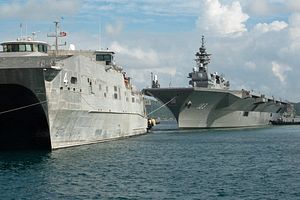This week, in a notable regional development, a Japanese submarine visited Vietnam for the first time. The move did not receive nearly as much attention as it should, perhaps because the interactions tied to the visit itself seem rather routine. Still, the significance of the visit is unmistakable from the perspective of both countries, their strengthening defense ties, and the wider regional context.
The Japanese Maritime Self-Defense Force (JMSDF) submarine Kuroshio docked at Cam Ranh International Port in Kham Hoa on September 17, commencing what was characterized as a scheduled five-day visit. The Vietnamese defense ministry correctly noted that the visit itself consisted of the usual elements in such interactions, including courtesy calls on Vietnamese officials and naval personnel, sports and professional interactions, and cultural activities including tours. But while the interactions themselves may seem routine, the significance of the first-ever Japanese submarine visit is unmistakable in several senses.
First, at a general level, it is just the latest manifestation of the building of intraregional security relationships between like-minded states in the Asia-Pacific. As I have observed repeatedly in these pages, the confluence of several trends, including a growing list of traditional and nontraditional security challenges and the rise of more informal kinds of alignments, has catalyzed the formation of looser links between regional states under the banner of regional strategies or outlooks, with the Indo-Pacific being just one of them (See: “Trump’s Indo-Pacific Strategy Challenge in Focus at 2018 Shangri-La Dialogue“).
One of those shifting relationships has been that between Japan and Vietnam. Over the past few years, the two countries have been boosting their security ties as part of their so-called extensive strategic partnership, with Vietnam seeing Japan as one important power to engage in its wider omnidirectional foreign policy, and Japan viewing Hanoi as a key node in its greater engagement of Southeast Asia and as part of its own Indo-Pacific strategy, which dates back over a decade to Shinzo Abe’s first stint as prime minister from 2006 to 2007 (See: Southeast Asia’s Role in Japan’s Indo-Pacific Strategy”).
Indeed, the submarine visit is just one of several defense-related developments we have seen in the past few years as the two sides commemorate the 45th anniversary of the establishment of their diplomatic ties in 2018. Those gains include not just headline items such as periodic maritime security assistance, but significant moves including new naval drills, Japanese port calls, an agreement on coast guard cooperation, and discussions on more defense equipment and defense industrial collaboration.
Second and more specifically, the submarine visit is just the latest manifestation of Japan’s efforts to play a more active security role in the region under Prime Minister Shinzo Abe. While Tokyo has played such a role for decades, there has been a greater emphasis on certain aspects in recent years, including the cultivation of stronger defense ties with countries in Southeast Asia such as Vietnam as well as a more robust role when it comes to areas of focus such as the South China Sea.
The submarine visit itself was testament to this. While it was carefully messaged as a separate engagement from the Vietnam visit, the Kuroshio, along with three other Japanese vessels, had also just taken part in an anti-submarine warfare exercise that was held in the South China Sea. As with other such sequential engagements that have been occurring involving major powers, including the United States, the separation was important but the messaging was nonetheless clear.
Third, the submarine visit is also a further indicator of Vietnam’s growing willingness to boost security ties (within limits) with major powers, including those within the U.S. alliance and partnership network. Vietnam carefully calibrates such interactions with major powers down to the type of vessel involved, and this is particularly the case with countries such as the United States or Japan given the sensitivities that this can generate with respect to Hanoi’s ties with China. This is especially true since Beijing has grown bolder in the sorts of pressure it exerts on Hanoi in response to such perceived slights (See: “China-Vietnam South China Sea Spat in the Spotlight“).
In that context, Hanoi’s decision to accept a first submarine visit is significant. While this is something that has been carefully calibrated over time, it is nonetheless the sort of move that will clearly irk Beijing, especially given its proximity to a South China Sea-related activity that involves Japan. It is also worth noting that this interaction is far from an isolated event. Indeed, shortly after Japan’s first submarine visit to Vietnam, a Vietnamese frigate is set to visit Japan in late September out to early October in yet another significant defense-related development.
To be sure, such developments ought to be kept in perspective, especially given the fact that Vietnam has also treaded relatively more cautiously on some other elements of defense ties with major powers, and the reality that it tends to balance such moves with continued attempts to manage its relations with China as well. Yet for all the aforementioned reasons, a first-ever submarine visit for Japan in Vietnam is far from a routine development.































